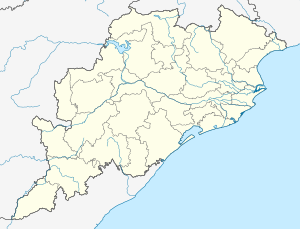Kotgarh Wildlife Sanctuary
Kotgarh Wildlife Sanctuary is situated in the Baliguda subdivision of Kandhamal district of Odisha state in India. It is classified as an Eastern Highlands moist deciduous forest. Around 52 tribal villages such as Kutia Kondh and Desia Kondh inhabit the sanctuary.
| Kotgarh Wildlife Sanctuary | |
|---|---|
| କୋଟଗଡ ବନ୍ୟଜନ୍ତୁ ସଂରକ୍ଷଣାଳୟ | |
IUCN category IV (habitat/species management area) | |
 Location of Kotgarh Wildlife Sanctuary in Odisha | |
| Nearest city | Baliguda |
| Coordinates | 19.8601157°N 83.621099°E |
| Area | 399.05 km2 (154.07 sq mi) |
| Designation | Wildlife Sanctuary |
| Designated | December 3, 1981[1] |
| Governing body | Divisional Forest Officer, Baliguda Division, Kandhamal district, Ministry of Forest and Environment, Government of Odisha[2] |
About
Designated and proposed reserve forests include Madagoda 36.02 km2 (14 sq mi), Haripur 42.66 km2 (16 sq mi), Lassery72.96 km2 (28 sq mi), Bonduru3.67 km2 (1 sq mi), Supamaha7.55 km2 (3 sq mi), Killangi6.073 km2 (2 sq mi), Subarnagiri30.04 km2 (12 sq mi) and Guma14.04 km2 (5 sq mi).[1][3]:340 Kotgarh sanctuary spreads over Kotgarh jurisdiction, Tumudibandha range and Daringbadi block in Kandhamal district.[4]
Kotgarh is nominated to be a part of the proposed 14 elephant corridors for safe movement of the elephants which frequently come out of their habitation in search of food and water.[5]
Flora
The main vegetation of the sanctuary consists of dense moist deciduous forests with grasslands. The floral diversity of the sanctuary consists of 650 plant species that include angiosperms, pteridophytes, gymnosperms, bryophytes, lichens and fungi. The dominant flora includes Sal, Piasal, Sisoo, Kendu, Gamhar, Asan, Kusum, Harida, Bahada, Amala, Mango, Tamarind, Mahua, Jackfruit, Randhan, Kangada, Jamun, Salapo, Bheru, Arjun, Char, Dhaura and Kochila.
There are many rare and endangered medicinal plants including Abutilon indicum, Cissus quadrangularis, Crateva magna, Cycas sphaerica, Garcinia xanthochymus, Gardenia gummifera, Gloriosa superba, Justicia adhatoda, Litsea glutinosa, Oroxylum indicum, Pueraria tuberosa, Rauvolfia tetraphylla, Saraca asoca, Steriospermum suaveolens, Symplocos racemosa, Tinospora cordifolia and Zanthoxylum armatum| Zanthoxylum rhetsa.[6]
Fauna
Animal species present in this sanctuary include Tiger, elephant, Gaur, Sambar deer, Spotted deer, Peafowl, Red jungle fowl, Black buck, Leopard, Sloth bear, Chital, other bird species and reptiles including rare species such as Boiga forsteni.[3]:340[3]:243[7][8]
Attractions
A wooden bungalow at Belghar attracts many nature loving visitors.
How to reach
By Road : Baliguda is connected with Berhampur and other cities of Orissa via NH-59.
By Rail : Nearest Rail Head is at Berhampur on S.E. Railway 180 km from Muniguda.
By Air : Nearest Air Port is at Bhubaneswar which is 291 km from Balliguda
See also
. MAA Bhavani Mata upasana pitha .kesariguda,kotagarh,kandhamal
References
- Bhattacharya, edited by Ajoy Kumar (2007). Forestry for the next decade : managing thrust areas. New Delhi, India: Concept Publishing Company. p. 265. ISBN 8180694275.CS1 maint: extra text: authors list (link)
- "Kotagarh Sanctuary". Odisha Wildlife Organisation. Retrieved 30 March 2018.
- Bhargava, ed. S.C. Bhatt, Gopal K. (2006). Orissa. Delhi: Kalpaz publ. ISBN 8178353776.CS1 maint: extra text: authors list (link)
- "Kotagarh Sanctuary info". Odisha Wildlife Organization. Retrieved 30 March 2018.
- Mohanty, Debabrata (2 May 2016). "Odisha: Elephant corridor notification pending since four years despite rising deaths". The Indian Express.
- Barik, Bibhuti (3 January 2011). "Kotgarh sanctuary: A haven for wildlife". The Telegraph (Calcutta).
- Servheen, compiled by Christopher; Herrero, Stephen; Moll, Bernard Peyton; IUCN/SSC Bear Specialist Group, IUCN/SSC Polar Bear Specialist Group; editorial assistance by Kristy Pelletier, Kana Moll, Joseph (1999). Bears : status survey and conservation action plan. Gland, Switzerland: IUCN. p. 231. ISBN 2831704626.
- Negi, S.S. (1993). Biodiversity and its conservation in India. New Delhi: Indus. p. 13. ISBN 8185182884.